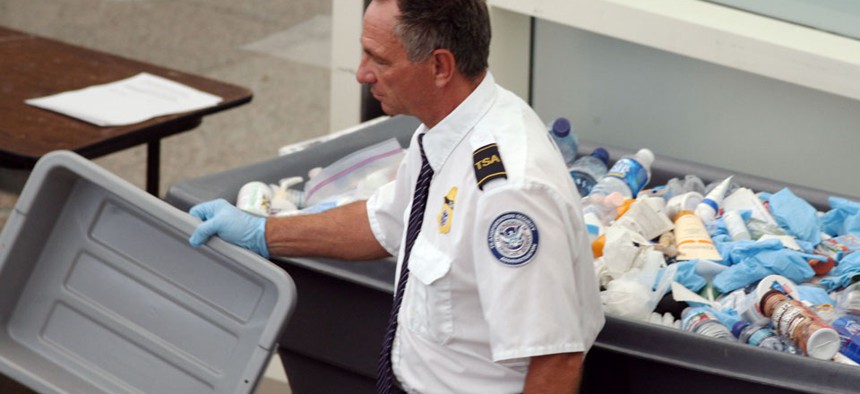Drink Up: DHS-funded Liquid Scanner Could Lift Airport Ban on Larger Bottles

A TSA worker empties bottles into a bin filled with confiscated items at Denver International Airport. David Zalubowski/AP file photo
The cooler-like box uses magnetic resonance imaging in conjunction with X-rays to quickly detect explosive substances.
Airplane passengers could in the future bring wine, gravy and cranberry sauce onboard for the holidays.
The Energy Department’s Los Alamos National Laboratory recently demonstrated a magnetic resonance imaging system, called "MagRay," that developers say is better than X-rays at differentiating bomb-making substances from benign substances.
The bottle screener uses the same technology hospitals use for scanning body tissue.
The project was partially funded through the Homeland Security Department and the system, resembling a beverage cooler, is potentially inexpensive, Energy officials say. But it remains to be seen whether DHS will approve the machine and when.
"A technique like magnetic resonance is very well suited for looking at liquids and gels. It's the premier method, for example, for looking at soft tissue in a hospital or medical imaging setting," MagRay project leader Michelle Espy said in a YouTube video. TSA banned most carry-on beverages and toiletries in 2006, after authorities foiled a plot to bomb U.S.-bound planes with liquid explosives.
Today, the public is restricted from flying with more than a quart-size Ziploc bag of bottles, none of which may exceed 3 oz. This is partly because the traditional carry-on baggage scanning method -- X-rays -- misses certain threat indicators, Espy said.
What appears to be a bottle of white wine could be nitromethane, an ingredient for explosives. With the new approach, Transportation Security Administration screeners could rapidly and accurately discriminate between liquids that look identical, Energy officials say.
The new system assesses proton content, MRI measurements of the sludgy-ness of liquids, and X-ray density data, MagRay engineer Larry Schultz said in the video.
The goal would be for TSA screeners to simply insert a bottle into the machine and, without any calibrating, see a display consisting of “not much more than red light, green light -- either this is bad or you can let this go," Schultz said.
This is not the first successful show of bottle scanning technology. Scandinavian airports, London's Heathrow, as well as the U.K.'s Aberdeen, Glasgow International and Southampton airports have purchased liquid screeners from Battelle, a nonprofit institute in Ohio. The systems, which look like large cup holders, rely on radio frequency and ultrasonic technology. Just this month, Brisbane and Sydney Airports also bought the technology, according to Battelle officials.
NEXT STORY: As Bitcoin Booms, So Does Bitcoin Bank Robbery






